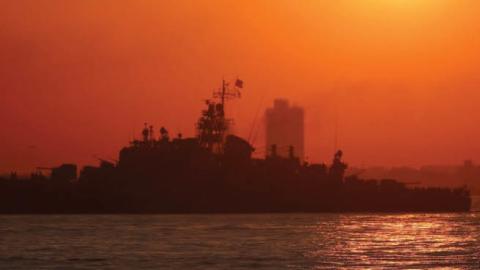A highly unusual development has thrust itself into the Middle East: some good news. As usual, the Middle East is beset by turmoil and is likely to remain so for the next four years. But new and positive responses to these threats have changed the Middle Eastern landscape. A crucial question for the next four years is whether the U.S. will build successfully on these positive developments or risk their withering away.
These positive developments include, most notably, two new alliances of America’s regional friends. These may be capable of giving America serious assistance in the pursuit of its national interests in the region, not to mention their own. If so, they would fulfill a longstanding American hope of a reduction in the burdens it has borne.
The first and most obvious change is the new alliance between Israel and two Gulf states, the United Arab Emirates (UAE) and Bahrain, members of what is called the pragmatic Sunni Arab bloc. This alliance is understood to have at least the implicit support of others, including notably Saudi Arabia, and has the prospect of growing wider and even more capable with the potential inclusion of additional states.
The second, somewhat less noted, positive development is the formation of an alliance in the Eastern Mediterranean designed to protect the region’s waters and their energy resources. Somewhat ad hoc in nature, it now consists of the following countries: Egypt, Greece, Cyprus, Israel, Jordan, France, and the United States, with a possible role for Italy.
Of course, these alliances are the flip side of the threats to peace and stability that the region faces, forces that threaten American interests as well. These are threefold. Two are internal to the region: the revolutionary Shiite regime of the Islamic Republic of Iran and the ambitious and increasingly Islamist orientation of the regime of the Republic of Turkey under its leader, Tayyip Erdogan. To them may be added their respective non-state radical-Islamist allies. But they are now augmented by a third hostile force of external powers and American adversaries: Russia and China, which increasingly seek a powerful role in the region.
It is now a matter of record that the two new alliances were summoned into existence to meet the two intraregional threats. This has been most clear in relation to the Islamic Republic of Iran. Ruled for some four decades by a revolutionary regime, it has sought from its founding to export its revolution and achieve, at a minimum, a regional hegemony. It has pursued this course with especial vigor over the past 20 years, building what has been called the Shiite Crescent. This was facilitated by the Arab revolts of 2011 known as the Arab Spring, and the chaos and civil wars that have ensued. Iran now exercises great power in the Arab states of Iraq, Syria, Lebanon, and Yemen. As its successes mounted, Sunni Arab states felt more and more threatened. In the end, their anxiety led to agreements to normalize relations with Israel.
The pragmatic Arab states’ outreach to Israel was aided by another important factor — their weariness with the Palestinians’ corrupt and rejectionist leaders. Herein lies a third positive development — the U.S. and the region have sloughed off the long-held and erroneous conventional view that progress in the region required first somehow appeasing unreasonable Palestinian demands.
But this alliance was also summoned forth by the threat of the Republic of Turkey. That this was a serious threat was for a long time unclear. Indeed, it has been tempting to look away from and deny the threats from this quarter, and that temptation has been yielded to. After all, Turkey has been an American ally for nearly 70 years through NATO and other relationships. Moreover, the beginnings of the present regime of President Tayyip Erdogan were greeted with much enthusiasm by America and other countries. It claimed to be, and was accepted as, a new project combining Islam and democracy that offered the prospect of new regional progress and stability.
But beginning not later than 2010, it began to emerge that Erdogan had in mind a much different and radical course for Turkey. This showed in policies designed to export his revolution and promote a neo-Ottoman revival of Turkish greatness and hegemony. This too was facilitated by the revolts of 2011 and their aftermath. Over time, this became impossible to simply ignore. The Arab states that have now normalized their relations with Israel, as well as others that have effectively given their blessing, have made clear that the Turkish threat is also responsible.
Moreover, recently, and in the pursuit of his ambitions, Erdogan has gone so far as to claim sovereignty over practically the entire Eastern Mediterranean, and backed it up with an intervention in Libya, threats against Egypt, and threats against Greece and Israel. Erdogan’s “blue homeland” ambitions are the dark side of a fourth positive development in the region: the opportunity to exploit vast underwater natural-gas reserves in the Eastern Mediterranean. Gas from these fields has augmented and will continue to augment the economies and security of Israel, friendly regional states, including Jordan and Egypt, and even European powers.
The need to respond to Erdogan’s lunge toward these resources has led to the second new alliance binding Israel with other Mediterranean states. America’s underlying air and naval strength has played and will continue to play an important part in bolstering the confidence and cohesion of this new alliance and in allowing the region’s energy resources to be put to good use.
Of course, of the two threats driving our allies, the Iranian one goes back farther in time and is greatly increased by Iran’s long and determined pursuit of nuclear weapons. For at least the past four years, America has had a program of “maximum pressure” in place that, along with lower oil prices, has succeeded in weakening the Iranian regime. A malevolent and guiding Iranian figure, General Qassem Suleimani, was eliminated in a U.S. strike designed to disrupt future Iranian support for terror and subversion. In these successful efforts to weaken Iran lies a fifth positive development for the region.
In countering Turkey’s pursuit of Erdogan’s hegemonic dreams, the U.S. and its allies will face difficult policy choices. Turkey remains a NATO ally and a major regional power. In some ways, Turkey still helps to counter other malign influences in the region. Its geographic location can be an important check on Russian influence. If Turkey is pushed to extremes, Erdogan’s actions — for example, allowing hundreds of thousands of Syrian refugees to flee into Europe — could further complicate prospects for U.S. allies. Turkey historically has often been a rival of Iran, but Erdogan has spoken of his close ties to that revolutionary state. U.S. and regional diplomacy will be stretched to balance these various interests while pushing back against Erdogan’s excessive claims and destabilizing ambitions.
In short, in addition to the many threats we continue to face, there are positive developments in the Middle East that the next administration — Republican or Democratic — would do well to sustain. There will be pressures to sacrifice these for other interests: securing the elusive settlement of Palestinian demands, inducing Iran to curb its nuclear ambitions, keeping Turkey from embracing too closely Chinese, Russian, or Iranian ties, for example.
America has often in the past allowed wishful thinking to blind it to unpleasant realities about potential foes. History in this region tells a cautionary tale. In facing the choices that lie ahead, the next U.S. administration would do well to weigh the opinions of our Middle Eastern allies, precisely because they share our interests in countering mutual threats. We will need to draw on the new insights and realities that mark the region and to cultivate the two new and capable alliances that America has helped to foster.
Read in National Review




















